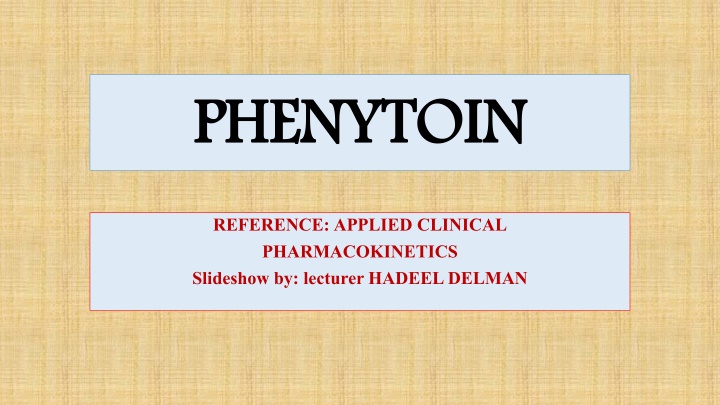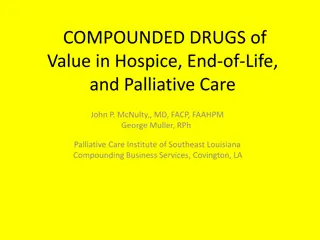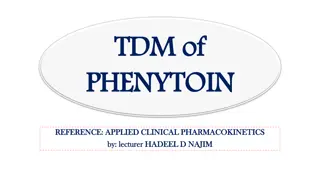
PHENYTOIN
Phenytoin, a drug used to treat seizures, is highly bound to albumin in the body. Maintaining serum concentrations within the therapeutic range of 10-20 μg/mL is crucial to avoid adverse effects such as drowsiness, nystagmus, ataxia, and mental status changes. Factors that can displace phenytoin from albumin binding sites include insufficient binding proteins and interactions with other compounds. Monitoring unbound phenytoin levels is important for optimizing therapy efficacy and minimizing side effects.
Download Presentation

Please find below an Image/Link to download the presentation.
The content on the website is provided AS IS for your information and personal use only. It may not be sold, licensed, or shared on other websites without obtaining consent from the author. If you encounter any issues during the download, it is possible that the publisher has removed the file from their server.
You are allowed to download the files provided on this website for personal or commercial use, subject to the condition that they are used lawfully. All files are the property of their respective owners.
The content on the website is provided AS IS for your information and personal use only. It may not be sold, licensed, or shared on other websites without obtaining consent from the author.
E N D
Presentation Transcript
PHENYTOIN PHENYTOIN REFERENCE: APPLIED CLINICAL PHARMACOKINETICS Slideshow by: lecturer HADEEL DELMAN
phenytoin is phenytoin is highly bound (~90%) to albumin, highly bound (~90%) to albumin, The serum concentrations in the treatment of seizures is 10 The usual therapeutic range for total (unbound + bound) phenytoin serum concentrations in the treatment of seizures is 10- -20 usual therapeutic range for total (unbound + bound) phenytoin 20 g g/mL /mL The normal plasma protein binding is (10%) The usual unbound normal plasma protein binding is (10%) usual unbound fraction ( fraction (fB fB) ) of phenytoin in individuals with of phenytoin in individuals with Unbound phenytoin serum concentrations 1 Unbound phenytoin serum concentrations 1 2 2 g/ g/mL. mL.
Adverse effects related to serum conc. Adverse effects related to serum conc. >15 g/mL drowsiness or fatigue g/mL- ------- drowsiness or fatigue. . ------minor central nervous system depression minor central nervous system depression such such as as > > 20 20 g/mL g/mL- -------- -------nystagmus nystagmus, , lateral lateral gaze gaze > > 30 30 g/mL g/mL- --------- --------ataxia, ataxia, slurred speech slurred speech, and/or , and/or incoordination incoordination > mentation, severe > 40 mentation, severe confusion or lethargy, and coma are possible 40 g g/mL /mL- ---------- --------- mental status changes, including decreased confusion or lethargy, and coma are possible. . mental status changes, including decreased > 50 > 50 g/mL g/mL ---------- ----------Drug Drug- -induced induced seizure seizure activity. activity.
Since phenytoin is highly bound (~90%) to albumin, you need to know factors cause displacement from binding site------- fB fB ( (1) Lack of binding protein 1) Lack of binding protein due to insufficient due to insufficient plasma plasma conc. conc. of of ( ( albumin), albumin), (2) Displacement of phenytoin from albumin binding sites by compounds, (2) Displacement of phenytoin from albumin binding sites by endogenous compounds, endogenous (3) Displacement of phenytoin from albumin binding sites by compounds (3) Displacement of phenytoin from albumin binding sites by exogenous compounds exogenous
Unbound phenytoin patients binding. Unbound phenytoin serum concentration patients with known reasons to have altered binding. serum concentration monitoring with known reasons to have altered drug plasma monitoring restricted drug plasma protein restricted to protein to For example patient has a satisfactory anticonvulsant response, would be abnormal plasma protein binding ( unidentified Cf = fB . C = 0.2 . 5 ------ not within therapeutic range = 1 g/mL ------ within therapeutic range For example, if low patient has a satisfactory anticonvulsant response, one possible reason would be abnormal plasma protein binding (fB fB = 20 unidentified reason . , if low total total phenytoin concentration (C=5 phenytoin concentration (C=5 g g/mL), and /mL), and one possible reason = 20%) for %) for some some reason .
Conversely Conversely,,,, ,,,, If a and the total phenytoin concentration is within the therapeutic range (15 A possible reason unidentified reason, Cf = fB . C = 0.2 15 g/mL ------ within therapeutic range = 3 g/mL ------ toxic If a patient has a possible phenytoin and the total phenytoin concentration is within the therapeutic range (15 g/mL), A possible reason could be abnormal protein binding (20%) for an unidentified reason, patient has a possible phenytoin- -related related adverse drug adverse drug reaction reaction g/mL), could be abnormal protein binding (20%) for an
Methods to estimate unbound phenytoin Methods to estimate unbound phenytoin concentrations ( concentrations ( C Cf f) ) 1 1- -normalized total normalized total phenytoin concentration C Normal Binding = C /(X Alb + 0.1) C CNormal C C is the actual measured phenytoin concentration in X X is a constant equal 0.2 (if 0.25 (if 0.1 (If the patient has end Alb phenytoin concentration C Normal Binding = C /(X Alb + 0.1) Binding is the normalized total phenytoin concentration in is the normalized total phenytoin concentration in g/mL, g/mL, Normal Binding is the actual measured phenytoin concentration in g/mL , is a constant equal to: 0.2 (if protein binding measurements 0.25 (if conducted at 0.1 (If the patient has end- -stage renal disease Alb is the albumin concentration in g/mL , to: protein binding measurements conducted conducted at 25 stage renal disease Crcl is the albumin concentration in g/ g/dL conducted at at 37 37 C) C) 25 C) C) Crcl<10 <10 15 mL/min), 15 mL/min), dL
2 2- - Compute estimated free concentration ( Cf EST = 0.1 C Normal Binding for patients with concurrent valproic acid administration unbound (PHT in (VPA in Compute estimated free concentration (Cf Cf EST = 0.1 C Normal Binding Cf EST): EST): for patients with concurrent valproic acid administration unbound phenytoin concentration ( CfEST = ( (PHT in g/mL) total phenytoin concentration (VPA in g/mL) valproic acid concentration phenytoin concentration (C CfEST CfEST = (0.095 + 0.001 g/mL) total phenytoin concentration g/mL) valproic acid concentration fEST) ) is estimated VPA)PHT is estimated through: through: 0.095 + 0.001 VPA)PHT CfEST = (0.095 + 0.001 VPA)PHT This phenytoin concentrations (1 adjustment purposes. This value is compared to the usual therapeutic range phenytoin concentrations (1 2 2 g/mL) and used for dosage adjustment purposes. value is compared to the usual therapeutic range for unbound g/mL) and used for dosage for unbound
Example 1 hypoalbuminemia clearance = 90 mL/min). His total that any unbound concentrations performed by the clinical laboratory will be conducted at this patient. Example 1 JM is an epileptic patient being treated with phenytoin. He has hypoalbuminemia ( (albumin = 2.2 g/ clearance = 90 mL/min). His total phenytoin concentration is 7.5 that any unbound concentrations performed by the clinical laboratory will be conducted at 25 this patient. JM is an epileptic patient being treated with phenytoin. He has albumin = 2.2 g/dL phenytoin concentration is 7.5 g/ g/mL dL) and normal renal function (creatinine ) and normal renal function (creatinine mL. . Assuming Assuming 25 C C, compute an estimated normalized phenytoin concentration for , compute an estimated normalized phenytoin concentration for 1. Choose appropriate equation to estimate normalized total phenytoin concentration at the appropriate temperature. C Normal Binding = C/(0.25 Alb + 0.1) = (7.5 g/mL) / (0.25 2.2 g/dL + 0.1) = 11.5 g/mL CfEST = 0.1 C Normal Binding = 0.1 11.5 g/mL = 1.2 g/mL
Example acid function valproic an Example 3 3 PM acid. . He function (creatinine valproic acid an estimated PM is is an has a a normal (creatinine clearance acid concentrations estimated unbound an epileptic normal albumin clearance = = 90 concentrations are unbound phenytoin epileptic patient albumin concentration 90 mL/min) are 7 7. .5 5 g/mL phenytoin concentration patient being concentration (albumin mL/min). . His g/mL and concentration for being treated (albumin = = 4 4. .2 2 g/ g/dL His steady and 100 for this treated with phenytoin and dL) ) and state total g/mL, , respectively this patient with phenytoin and valproic and normal total phenytoin respectively. . Compute patient. . valproic renal He has normal renal phenytoin and Compute steady- -state 100 g/mL and 1. Choose appropriate equation to estimate unbound phenytoin concentration. CfEST = (0.095 + 0.001 VPA)PHT = (0.095 + 0.001 100 g/mL)7.5 g/mL = 1.5 g/mL Choose appropriate equation to estimate unbound phenytoin concentration.
Dosage Dosage forms forms For parenteral use , 1- Phenytoin sodium, the sodium salt of phenytoin, contains (92% phenytoin) Infusion rate<50 mg/min 2- Fosphenytoin, a water soluble phosphate ester prodrug of phenytoin. Infusion rate <150 mg/min For oral use 1- Capsules contain phenytoin sodium (92% phenytoin) extended phenytoin sodium capsules or prompt phenytoin capsules 2-tablets and suspension contain phenytoin (100%) Phenytoin tablets (50 mg, chewable) and Suspension (125 mg/5 mL)
The clinical implication of The clinical implication of Michaelis pharmacokinetics Michaelis- -Menten Menten pharmacokinetics The pharmacokinetics, The clearance pharmacokinetics, but clearance of of phenytoin phenytoin is is not but is is concentration not a a constant constant as as it it is is with dose- -dependent with linear linear concentration- - or or dose dependent. . As decreases As the decreases as as the the dose dose or or concentration the enzyme concentration of of phenytoin enzyme approaches phenytoin increases, approaches saturable increases, the saturable conditions the clearance conditions: : clearance rate rate Cl = Vmax / (Km + C )
Cl = Vmax / (Km + C) Vmax C C is is the phenytoin Km Vmax is the maximum rate of metabolism in mg/d, the phenytoin concentration in mg/L, Km is the substrate concentration in mg/L, is the maximum rate of metabolism in mg/d, concentration in mg/L, is the substrate concentration in mg/L,
Example average Michaelis-Menten constants of Vmax = 500 mg/d and Km = 4 mg/L. Find the clearance of the therapeutic range of phenytoin (10 20 g/mL). Example.. phenytoin follows saturable pharmacokinetics with Cl = Vmax/(Km + C) = (500 mg/d) / (4 mg/L + 10 mg/L) = 36 L/d Cl = (500 mg/d) / (4 mg/ + 20 mg/L) = 21 L/d
findV, V,t t1/2 for a 70 for a 70- -kg person kg person find 1/2 V V = 0.7 L/kg t t1/2 t t1/2 = 0.7 L/kg 70 kg 1/2 = [ = = [0.693 1/2 = [0.693 70 kg 50 V] / Cl Cl 50 L] / 36 50 L] / 21 50 L, L, = [0.693 [0.693 50 L] / = [0.693 50 L] / 0.693 V] / 36 L/d = 21 L/d = L/d = 1 1 d d L/d = 1.7 1.7 d d Half (10 Half- -life increase (10 g/mL) life increaseas g/mL) to as phenytoin serum concentrations increase from to (20 phenytoin serum concentrations increase from (20 g/mL). g/mL).
Return to child pough child pough score and score and interactions interactions changes that occur with decreased protein binding of phenytoin according to the scheme.
Concomitant use with valproic acid Concomitant use with valproic acid Initially competitive As inhibition The from but increase Initially, , valproic competitive displacement As valproic inhibition component The net from baseline, but unbound increase. . valproic acid displacement for valproic acid component of of the net result baseline, unbound phenytoin decreases phenytoin for binding acid concentrations the drug result is is total phenytoin plasma binding sites concentrations increase drug interaction total phenytoin acid decreases plasma protein sites on increase, , the interaction comes phenytoin concentrations protein binding binding via via on. . the hepatic comes into are largely hepatic enzyme into play largely unchanged enzyme int) ). . unchanged play ( ( Cl Cl int concentrations are phenytoin concentrations concentrations and and pharmacologic pharmacologic effect effect
INITIAL DOSAGE DETERMINATION METHODS INITIAL DOSAGE DETERMINATION METHODS Pharmacokinetic Dosing Pharmacokinetic Dosing Method Method Literature Literature- -Based Recommended Dosing Based Recommended Dosing
Pharmacokinetic Dosing Method Pharmacokinetic Dosing Method MICHAELIS-MENTEN PARAMETER ESTIMATES VOLUME OF DISTRIBUTION ESTIMATE SELECTION OF APPROPRIATE PHARMACOKINETIC MODEL AND EQUATIONS STEADY-STATE CONCENTRATION SELECTION
Estimates Estimates V Vmax max & K & Km m Adults renal function as well as normal plasma protein binding (~90%), have an Adult ( (range: younger = 6 older Adults without the disease states and conditions renal function as well as normal plasma protein binding (~90%), have an average phenytoin Adult Vmax range: 1 15 g/mL younger children (6 months = 6 g/mL while older children (7 without the disease states and conditions with normal liver with normal liver and and average phenytoin Vmax of of 7 mg/kg/d g/mL). ). children (6 months 6 years) g/mL while children (7 16 years) 7 mg/kg/d (range: 1.5 (range: 1.5 14 mg/kg/d) and Km of 4 14 mg/kg/d) and Km of 4 g/mL g/mL 6 years) are are Vmax Vmax = 12 mg/kg/d and Km = 12 mg/kg/d and Km 16 years) Vmax Vmax = 9 = 9 mg/kg/d and mg/kg/d and Km = 6 Km = 6 g/ g/mL. mL.
Estimate Volume Of Distribution Estimate Volume Of Distribution V= 0.7 L/kg For obese .. V = 0.7 L/kg [IBW + 1.33(TBW IBW)]
STEADY STEADY- -STATE STATE CONCENTRATION SELECTION CONCENTRATION SELECTION For the treatment of seizure Required total phenytoin concentration 10- 20 g/mL Required free phenytoin concentration 1-2 g/mL
SELECTION OF APPROPRIATE SELECTION OF APPROPRIATE PHARMACOKINETIC MODEL AND EQUATIONS PHARMACOKINETIC MODEL AND EQUATIONS Vmax metabolism in mg/d S S is the fraction of the form that is active phenytoin ( phenytoin sodium injection and capsules; for phenytoin acid suspensions and tablets Km the Vmax is the maximum rate of metabolism in mg/d, , is the fraction of the phenytoin salt form that is active phenytoin (0.92 for phenytoin sodium injection and capsules; 0.92 for fosphenytoin, 1.0 for phenytoin acid suspensions and tablets), ), Km is the substrate concentration in the rate of metabolism = is the maximum rate of phenytoin salt 0.92 for 0.92 for fosphenytoin, 1.0 LD = (Css V)/S = 24 hr. for adult or 12hr for children or I.V dose is the substrate concentration in rate of metabolism = Vmax Vmax/2. /2.
Example partial normal regimen equal Example 1 1 TD partial seizures normal liver regimen designed equal to to 12 TD is is a a 50 seizures who liver and designed to to achieve 12 g/ g/mL 50- -year who requires and renal year- -old, requires therapy renal function achieve a a steady mL. . old, 75 therapy with function. . Suggest steady- -state 75- -kg kg ( (5 5 ft ft 10 with oral Suggest an state phenytoin 10 in) oral phenytoin an initial phenytoin concentration in) male phenytoin. . He initial phenytoin with simple He has phenytoin dosage concentration male with simple has dosage The The Vmax Vmax = 7 mg/kg/d for adult = 7 mg/kg/d for adult Vmax Vmax = 7 mg/kg/d = 7 mg/kg/d 75 kg 75 kg = 525 mg/d. = 525 mg/d. For this individual, Km = 4 mg/L. For this individual, Km = 4 mg/L.
Compute dosage Compute dosage regimen: regimen: for for oral extended oral extended phenytoin sodium capsules phenytoin sodium capsules (S (S = 0.92). = 0.92). The initial dosage interval ( ) will be set to 24 hours. The initial dosage interval ( ) will be set to 24 hours.
Same patient but with IV phenytoin Same patient but with IV phenytoin Same V V = 0.7 LD = (V mg given at Same Vmax = 0.7 L/kg LD = (V Css mg given at a maximal Vmax=525, Km=4, S=0.92 L/kg 75 kg Css) / S = (53 L a maximal rate of 50 mg/min =525, Km=4, S=0.92 75 kg = 53 L ) / S = (53 L 12 mg/L) / 0.92 = 691 mg, rounded to 700 rate of 50 mg/min. . = 53 L. . 12 mg/L) / 0.92 = 691 mg, rounded to 700 MD, ( The infusion MD, ( ) will be set to 12 The dose will be: 400 mg/d infusion rate no greater than 50 mg/min. ) will be set to 12 hours. dose will be: 400 mg/d prescribed rate no greater than 50 mg/min. hours. prescribed as 200 as 200 mg mg every every 12 hours 12 hours
Example seizures who requires therapy with oral liver and renal function. Suggest an initial phenytoin dosage regimen designed to achieve a steady-state phenytoin concentration equal to 12 g/mL. Example 2 2 UO is a 10 10- -year year-old, 40-kg male with simple partial oral phenytoin phenytoin. He has normal 12 Vmax Vmax = 9 = 9 mg/kg/d. mg/kg/d. Vmax Vmax = 9 mg/kg/d = 9 mg/kg/d 40 kg 40 kg = 360 mg/d. = 360 mg/d. For this individual, Km = 6 mg/L. For this individual, Km = 6 mg/L.
Compute dosage Compute dosage regimen for... regimen for... Oral Oral phenytoin suspension phenytoin suspension ( (F = 1, S = 1). F = 1, S = 1). The initial dosage The initial dosage interval ( ) will be set to 12 hours. interval ( ) will be set to 12 hours. H.W// Solve the question using IV dosage of phenytoin H.W// Solve the question using IV dosage of phenytoin
Literature Literature- -Based Recommended Dosing Based Recommended Dosing MD for adult = 4 6 mg/kg/d MD for children (6 months 16 years old) = 5 10 mg/kg/d LD = 15 20 mg/kg For obese individuals (>30% over ideal body weight), adjusted body weight (ABW) use to compute loading doses.
Literature Literature- -Based Recommended Dosing Based Recommended Dosing If the patient has significant hepatic dysfunction (Child- Pugh score 8), maintenance doses prescribed using this method should be decreased by 25 50%
Example 1 1 TD partial seizures normal liver regimen designed equal to to 12 Example partial normal regimen equal TD is is a a 50 seizures who liver and designed to to achieve 12 g/ g/mL 50- -year who requires and renal year- -old, requires therapy renal function achieve a a steady mL. . old, 75 therapy with function. . Suggest steady- -state 75- -kg kg ( (5 5 ft ft 10 with oral Suggest an state phenytoin 10 in) oral phenytoin an initial phenytoin concentration in) male phenytoin. . He initial phenytoin with simple He has phenytoin dosage concentration male with simple has dosage MD for MD for adult adult = = 4 4 6 mg/kg/d 6 mg/kg/d Using a rate of 5 mg/kg/d, the initial dose would Using a rate of 5 mg/kg/d, the initial dose would be: be: 5 mg/kg/d 5 mg/kg/d 75 kg = 375 mg/d, rounded to 400 mg/d. 75 kg = 375 mg/d, rounded to 400 mg/d. Using Using a dosage interval of 24 a dosage interval of 24 hours. hours.
Repeat it with IV phenytoin dosage Repeat it with IV phenytoin dosage MD = 5 mg/kg/d, 5 mg/kg/d dosage interval of 12 hours, the prescribed dose would be 200 mg of phenytoin sodium injection every 12 hours. LD = 15 15 mg/kg faster than 50 mg/min MD = 5 mg/kg/d, 5 mg/kg/d 75 kg = 375 mg/d, rounded to 400 mg/d. Using a dosage interval of 12 hours, the prescribed dose would be 200 mg of phenytoin sodium injection every 12 hours. LD = 15 20 mg/kg. Using 15 mg/kg, 15 mg/kg 75 kg = 1125 mg, rounded to 1250 mg. given no faster than 50 mg/min 75 kg = 375 mg/d, rounded to 400 mg/d. Using a 20 mg/kg. Using 15 mg/kg, 75 kg = 1125 mg, rounded to 1250 mg. given no




